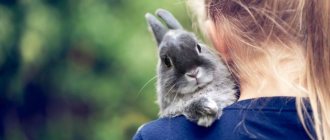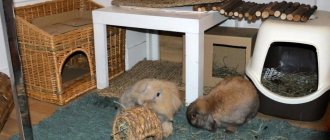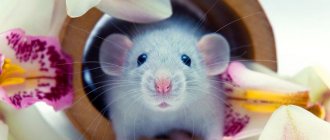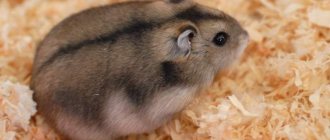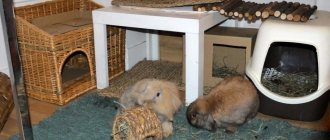What you need to keep a rabbit in the house
To keep a decorative rabbit at home, you need to stock up on equipment, which includes: a cage, a feeder, a rabbit house, toys and litter.
Cell
It should be spacious enough. An adult rabbit has considerable dimensions and loves freedom. Most use models with a tray that do not have a grill. They allow you to keep the bedding intact, providing a sufficient level of comfort for the rabbit. The only negative is that when using such models, much more replaceable filler is used.
Feeder
Note! For eared ones, models made of metal and porcelain are used. The best feeding options are those that have a relatively large weight and volume - it will be difficult for the animal to turn them over. A separate feeder is purchased for hay
A nipple drinker is best for supplying water; it will keep the liquid pure
A separate feeder is purchased for hay. A nipple drinker is best for supplying water; it will keep the liquid pure
The best feeding options are those that have a relatively large weight and volume - it will be difficult for the animal to turn them over. A separate feeder is purchased for hay. A nipple drinker is best for supplying water; it will keep the liquid pure.
Rabbit house
It is included in the list of optional items, but is purchased in most cases. A house can partially compensate for the lack of natural habitat, especially for females who have or will have offspring.
Rabbit house
Toys
If they are not there, the animal will play with everything in the cage. In this case, it will not last even a year.
Note! The product must be made from rabbit-edible materials (wood or straw)
Filler
A natural need for keeping many animals clean. In the case of a rabbit, large wood shavings are the best option.
Hygiene and care
Caring for rabbits at home is not very difficult, but this matter has its own nuances. A novice rabbit breeder may not know how important it is to maintain order in a rodent’s home. With poor quality care and irregular cleaning of the cage, the litter becomes contaminated with urine and feces. This leads to the formation of mold. Ammonia is released from the decomposing droppings, and the rabbit is forced to breathe toxic fumes. All this can lead to a decrease in the pet’s immunity and illness.
One of the most important aspects of caring for a decorative rabbit is maintaining cleanliness inside its home. The litter is changed every 5-7 days. During cleaning, the rodent is removed and the equipment is washed with hot water. The same is done with the pallet. The drinking bowl and feeder are scalded with boiling water.
The owner of a decorative rabbit, who wants to provide him with good living conditions and quality care, must carry out disinfection once a month. In this case, all parts of the cell are treated with special solutions to destroy microbes.
Grooming
It is important to maintain the beauty of the animal's fur. This is another important aspect of caring for a decorative rabbit. In representatives of long-haired breeds, the coat gets tangled and eventually becomes tangled.
Caring for the cover involves regular brushing. For this, a special comb is used, which helps remove lost hairs. The procedure is carried out 2 times a week. It is advisable to comb rabbits with long and thick fur every other day.
Attention! Rodents do not regurgitate fur like cats do. Ingested fur can cause intestinal blockage and tympany.
Rabbits are clean animals. They groom their fur using their tongue. But if the animal gets very dirty, it will have to be washed. Veterinarians do not recommend bathing rodents in water - it is very stressful for them. In addition, your pet may catch a cold.
It is best to wash the rabbit partially - wet and wipe with a rag only heavily soiled areas of the body - the fur on the cheeks and neck, near the anus, as well as the paws.
Nail care
Those who have decided to keep a decorative rabbit need to know how to properly care for their pet’s claws. The fact is that they gradually grow back and then begin to curl. This not only causes discomfort to the animal, but also poses a danger to its health. Deformed claws injure the paw pads and can even lead to musculoskeletal disorders.
Nail care involves regularly trimming overgrown tips. The procedure is carried out approximately once a month. To do this you will need a special tool. There are small nippers on sale with an oval guillotine-shaped hole - a very convenient thing for caring for animal claws. The end of the claw, about 1 mm long, is inserted into the slot of the nippers and carefully cut off.
Dental care
If the rabbit's diet is prepared correctly and contains enough solid food, then the rodent's teeth do not need care. In this case, they grind off on their own. However, pets often have problems with their incisors - they do not have time to wear off naturally, so they grow too long.
This leads to undesirable consequences:
- a decorative rabbit cannot eat or chew food normally;
- weight loss occurs;
- The mucous membrane of the lips is injured, stomatitis develops.
Rabbits that are kept at home often have to have their teeth trimmed to avoid such problems. The procedure is carried out in a veterinary clinic. To prevent excessive growth of incisors, you need to introduce not only hay, but also twig food into the menu of your decorative rabbit.
"Rex"
The very first short-haired rabbits appeared in France in 1919. For their unusual and valuable fur, they were given a sonorous name - “castor rex” (king of beavers). The resemblance to a beaver is really obvious - the animal has a red-brown fur color. And he received the title of king for the quality of the skin, which is very reminiscent of a chinchilla’s fur coat.
“Rex” is a dwarf rabbit (you can see the photo below), which has low hair, downy and guard hairs of almost the same length. They are half as long as their counterparts. This breed is characterized by underdeveloped whiskers - they are much smaller than those of other breeds and are often curved. At a very young age, a rabbit of this breed can be distinguished only by its antennae. When this species is crossed with ordinary ornamental individuals, the skins of the first-generation rabbits do not resemble the “Rex”.
Do you want to get a rabbit? Here's what you need to know
Contents hide
Do you want to get a rabbit? Here's what you need to know
Wonderful fluffy rabbits have their own army of loyal fans. Agree, it is impossible to pass by enclosures with rabbits sold in pet stores indifferently. I just want to hug this wonderful creature to myself as soon as possible. We are probably not the only ones with such thoughts in our heads! Are you thinking about bringing home a little bunny? Read this useful and informative review article - it will help you make a choice.
Is a rabbit right for you? The first thing I want to say is that a rabbit is a long-term responsibility. You will share a house and shelter with him for at least 5-7 years. Your rabbit will require proper care from you and should be fed and treated properly. In addition, a rabbit is an animal that should not be owned, as they say, “with your last money.” You are ready? Then you will get a wonderful, affectionate pet, with whom it is a pleasure to communicate.
It is important to choose a healthy rabbit. It is for this reason that we advise you to purchase an animal from trusted breeders - the chances of buying a known sick fluffy in this case are reduced to a minimum
Pay attention to the appearance of the animal you like. It should not be lethargic and lifeless
Before buying, it is best to prepare, read everything you find about the breed you like. Remember that the temperament of rabbits (from breed to breed) can vary significantly. Don't refuse the option to adopt a rabbit for free from a shelter!
Choosing a cage for a rabbit. The principle “the more the better” prevails here. Choose a spacious cage, consider the number of animals you plan to house
But take into account the fact that the cage will also have to be cleaned periodically! Therefore, everything should be simple and as functional as possible. The rabbit should fit freely in the cage and have some space to move around
Do not forget that it is not advisable to keep a rabbit in a cage twenty-four hours a day! This is a social animal; it needs exercise, training and communication with its owner and outside the cage. Decide in advance on the type of bedding, filler, buy toys and other accessories.
Feeding the rabbit correctly. In pet stores you will find an assortment of ready-made granulated food, selected specifically for rabbits. Of course, it can and should be used, but your pet’s diet will be incomplete without fragrant hay, and in the summer - without tasty meadow grass and fresh vegetables. Proper nutrition is the key to the health of your furry pet. The main condition is as many high-fiber foods as possible.
Rabbit toys. Rabbits are playful, active and inquisitive animals that play with their owners with visible pleasure. Provide them with a selection of suitable toys for play and variety of leisure activities. It is advisable that your rabbit is constantly busy with something interesting and attractive. Toys are an indispensable condition for maintaining good psychophysical shape of the animal.
We train a rabbit. Some breeds of rabbits can be trained to use a litter box (much like cats or ferrets), and cleaning problems will be much less. However, there are also “untrainable” specimens, and those that will require a lot of patience and attention from you. Variants of natural, normal behavior of rabbits - a lot of chewing and a lot of digging
With the first condition everything is more or less clear, with the second you will have to work hard: it is important to equip the cage and protect it correctly!
Caring for a rabbit. You will need the following: rabbits need to be combed, bathed from time to time, and their nails trimmed periodically. Don't neglect these procedures!
About the rabbit's health. Before purchasing a rabbit, call nearby clinics. Check to see if you and your pet will be welcome there. The fact is that veterinarians usually receive a narrow specialization to work with these animals. It turns out that there are not many qualified specialists around, and the prices for their services are steep. The main conditions for maintaining the health of a rabbit are adequate and proper nutrition, physical activity, constant communication with the owner, and regular preventive examinations by a veterinarian. Also, be sure to spay or neuter your rabbit to prevent many potential problems.
How to care for decorative rabbits - choosing a cage
Selecting a location
You should not place a cage with a rabbit next to the air conditioner or near the radiator. The optimal temperature for rabbits to live is +20° Celsius. Animals experience stress from loud noise, bright sunlight and being around other pets.
Does your rabbit live in a cool room? Poll Options are limited because JavaScript is disabled in your browser.
Arrangement
Rabbit feeders
There are several rules for choosing a rabbit feeder:
The container needs to be as easy to use as possible: so that it can be quickly removed and reattached and cleaned. Pay attention to the capacity of the feeder. Keep in mind that the feed mixture will be poured in for a long time, so the container must be large enough. Make sure there are no burrs, sharp cutting edges, or dangerous corners on the feeders.
Drinking bowls
The choice of devices for watering rabbits should be based on several basic criteria:
the drinking bowl must stand steadily on the surface so as not to overturn and contaminate the surface of the rabbitry; there should always be plenty of water in the drinker, therefore, it is advisable that the device is replenished automatically; it is important to maintain the purity of the water in the device, therefore, it is best to use a closed type of drinker; The material from which drinkers are made must be non-toxic.
Keeping the cage clean
Cleanliness is the key to health, and since rabbits are quite clean animals, it is recommended to disinfect them twice a year.
Rabbits love dandelions and clover
How are dwarf rabbits different from regular ones?
Sometimes it seems that the dwarf rabbit lives in order to please a person with its appearance and lift his spirits. However, this is not entirely true. These gentle little ones seem to be created for living in comfortable home conditions. Such rabbits are not raised for fluff or meat - they are exclusively pets that need human care and attention.
Future owners need to know how long dwarf rabbits live. With proper care, their life expectancy reaches twelve years. You should purchase an animal from a pet store or nursery. In this case, you need to understand the difference between a dwarf and an ornamental animal. The latter can be of different weights and dimensions. This is the main difference. Dwarf rabbits, whose size is always small, remain that way throughout their lives. If you buy a pet on the market, then you risk buying an ordinary rabbit, but at a young age. Besides, he may not be well.
Depending on the breed, dwarfs can have different weight and body length parameters - weight can range from 2.5 kg (loop-eared rabbits) to 1.5 kg (kids with erect ears). Different breeds may also differ in ear length. Most individuals have ears 6 cm long, but there are also hybrids whose ears reach twenty centimeters.
How do rabbits get along with other animals?
The question is controversial whether it is worth starting a zoo at home from different species of animals that are antagonists in nature. If you have even the slightest idea about animal psychology, start one. If you have no idea about competition in the animal world, hierarchy, who to feed first, who to feed later, who needs to be petted, who needs to be reined in. Then don't start it. Remember that keeping a rabbit at home is more difficult than keeping dogs and cats.
Photo. Oh, trouble, trouble! The owner also decided to get a rabbit. Vasya, maybe we can eat it, huh?
For example.
- It is possible to keep a rabbit together with reptiles if snakes and other reptiles live in a secure terrarium.
- Dogs. A predator can easily provoke an “interspecies” scandal and eat the baby rabbit on the very first day of purchase. It is usually not recommended to have rabbits in homes where there are dachshunds or other dogs designed for burrowing.
- Cats. These animals are very jealous, and underneath the outward indifference and play there may be a showdown. There are known cases of cats leaving home when a competitor appears.
- Birds. Shared content is almost always allowed. Birds and rabbits are animals of different elements (heaven and earth).
Accommodation features: rabbit house
If you decide to get rabbits and create a mini-farm in the village, then at the first stage you need to take care of their place of residence. A ready-made room for a rabbitry is created or used. The animals will be housed more compactly in 2-tier cages. Keeping rabbits indoors is more convenient and rational. Drafts and dampness, prolonged exposure to the sun should be avoided, but ventilation should be provided.
Outdoor home cage option
For a pet, the cage is placed away from heating appliances. If you raise a rabbit in a hot room, the rabbit will experience constant thirst and its health will worsen. It is not recommended to keep him in a cage all the time. In order for the indoor pet to feel good, it is allowed to run around the apartment.
Longer stay for pets - their cage
Keeping an animal’s “house” clean is an important condition for its health. Dirt and urine cause diseases of the respiratory system and eyes, so the tray is cleaned three times a week
Once a week, wash thoroughly using disinfectants.
Portable cage option
Feeders, drinking bowls, and hay mangers should be placed in the cage. They need to be well secured so that the animals cannot spill water or contaminate the food. They need to be washed as often as possible.
Animals love to eat indoor flowers. It is necessary to remove poisonous plants from the apartment, install the rest on cabinets or hang them in flower pots.
Is it possible to keep rodents together with chickens? Their cohabitation is possible only if there are no other options. Although they are completely different species, they have common diseases. In addition, the “eared” ones feel uncomfortable in the company of noisy and hectic hens. Therefore, keeping chickens and rabbits together is not recommended.
Rabbits can be trained
The second plus is that rabbits can be trained. Yes Yes! Someone told me that what are you doing, this is not a dog! Believe me, it’s really possible to train rabbits, and now I’m doing it. I can do it. Rabbits are capable of training almost like dogs, but a little more difficult,
The third plus is that rabbits can get along with your other pets. Rabbits can easily get along with your cat, dog, snail and or hamster.
Well, the fourth plus is that these animals do not make noise at night like hamsters. Those who have had hamsters know that they are active at night. They love to run in the wheel and rummage around there. It's not like that with rabbits. They may go out to eat, but it's not as noisy as some say.
The fifth plus is similar to the fourth. This is because rabbits are also nocturnal animals, but they can adapt to your schedule. If a month after the purchase, you go to bed at the same time and get up at the same time. So this is a rabbit's litter, they are smart animals. And they will go to bed and wake up with you. This is a huge plus.
Training and playing with your pet
Decorative rabbits just love to play
Dwarf rabbit breeds love to play and can learn some interesting tricks. They perceive training not as coercion, but as an opportunity to have fun. To achieve success, you need to eliminate negativity and aggression from the educational process. The best assistants in training will be praise and treating your pet with treats.
You should not start training your baby immediately after purchase. We need to give him a couple of months to adapt, after which he can begin training.
Pros of keeping rabbits at home
Not everyone can afford to keep exotic animals at home. If you want to get away from the traditional cat-dog option, you can get cute decorative rabbits. Moreover, there are several positive aspects of keeping animals at home:
Due to their cleanliness, rabbits always allocate a “toilet” area to the cage. Therefore, it is not difficult to restore order in the home of fluffies; animals do not show aggression
If you constantly feed animals by hand and pay attention to them, then after a while they will become attached to their owners; fluffy and incredibly soft fur is pleasant to stroke. This procedure always brings pleasure not only to pets, but also to owners; Caring for rabbits is not difficult and does not take much time
There is no need to bathe them regularly. Therefore, you can entrust older children with caring for the animal.
Advice! The pet's diet is simple. You can purchase special inexpensive food. To diversify the diet, the animal is fed carrots, apples, cucumbers, and fresh grass.
What are the disadvantages?
The appearance of any animals in the house has positive and negative sides. And, if everything is more or less clear with regard to cats or dogs, then caring for unusual animals raises a lot of questions. Before you get cute and harmless rabbits, you need to familiarize yourself with the disadvantages of keeping them:
- You should not count on manifestations of rabbit “intelligence”, even after several years of training. You can teach your furry pet to respond to its name. But you shouldn’t count on the “mutual understanding” shown by dogs or cats;
- To keep a pet you need a spacious cage. The animal also needs time every day to move freely around the house or yard. Therefore, every day you will have to monitor the movements of the fluffy for 2-3 hours;
- In terms of smells, you need to keep in mind that rabbits “mark” territory. The pet does not always get used to the tray; sometimes it may relieve itself in the wrong place;
- Rabbits are rodents, so it is impossible to wean your pet from the need to constantly chew something. It is important to remove all wires and cords from the floor. There is still a possibility of damage to wooden furniture.
See also
Nuances of winter breeding of rabbits and breeding rules for outdoor keepingRead
The animals are characterized by a nocturnal lifestyle. Therefore, the pet can sleep most of the time during the day, and eat and rustle at night. Rabbits also need daily grooming. If this procedure is neglected, wool will eventually appear on furniture and clothing.
Who is better boy or girl?
An excellent friend for a child. If the future owner does not plan to breed, then the gender of the animal does not matter much. To prevent problems of puberty from bothering the animals, they are castrated.
For males, this operation lasts only 30 - 40 minutes, for females - a little longer. Thus, get a pet of any gender, your love will not differ from the one who lives with you.
One animal or two?
A good choice is to buy two pets of different sexes for castration. In this case, it will be possible to avoid aggression, endless reproduction and other problems.
Keeping a pet decorative rabbit has more advantages than disadvantages. When kept in a cage or enclosure, these animals deliver a minimum of hassle and a maximum of positive emotions. If desired, they are walked with on a leash, just like with a puppy, go on picnics, and live in the country.
Breeds of dwarf rabbits
The painstaking work of breeders has made it possible to develop a wide variety of rodent breeds. Among them:
- Dutch rabbit;
- fold-eared Ram;
- Angora rabbit;
- lion breed rabbit;
- shorthaired colored.
Dutch rabbit
The Danish rabbit is one of the ten most popular types of rabbits. Compared to other breeds, the Dutch is a giant. Its weight can reach two and a half kilograms.
It has a large wide head, a rounded body, straight ears and short front legs. The Danish rodent has a distinctive feature - a white wedge from the ears along the nose.
With proper care, such an animal can live up to 10 years. In addition, it will not bring much trouble to the owner. The animal has a balanced character and a tendency to learn.
Lop-Eared Ram
The Lop-Eared Ram is the leader of all rabbits. This is the most popular among all dwarf rodents. Its weight reaches one and a half kilograms.
The Ram's head is only half the size of his body. The rabbit's muzzle is shortened, its eyes are set wide.
The main feature that will not allow you to confuse the ram with other species is the ears. They hang a couple of centimeters below the jawline.
Just like the previous one, this species is quite friendly and willing to be trained.
Angora rabbit
The Angora rabbit is very similar to a small fluffy ball, from which the ears and nose barely peek out.
The weight of the rodent is small - only 1.3 kilograms.
The fur is long. Quite soft and pliable
Please note that this type of fur is very prone to tangling, which is not good for the animal. The ears are straight, with tassels at the ends
Such an animal does not have a tendency to aggression.
Lion breed rabbit
The lion breed rabbit got its name because of its resemblance to the king of beasts.
The rabbit has a small body with a wide shoulder, which is covered with small hair. Weight can reach one and a half kilograms.
The head is not large, has a voluminous mane. Ears are straight. The fur on the chest can reach 7 centimeters.
The Lion Head has a good-natured character. In some places the animal may show timidity. The animal is very active, so it is worth taking care of a spacious cage.
Shorthair Colored
The colored rabbit is most suitable for keeping in apartment conditions.
The animal is small, the maximum weight does not exceed one and a half kilograms. But the body has a compact shape.
With proper care and upbringing, a short-haired rodent is calm and kind.
Conditions of detention
To properly keep a rabbit in an apartment, you need to know certain nuances:
- cannot tolerate overheating;
- direct sunlight is harmful;
- ideal temperature - +20 °C;
- air humidity - 50%;
- they are afraid of drafts.
Keeping a decorative rabbit in an apartment requires the presence of a spacious cage or enclosure with all the necessary equipment for normal life. Read about the most popular breeds of decorative rabbits.
Why is it not recommended to keep them in cages?
For a rabbit to be healthy, movement is very important for it. A cage up to 1 meter in size cannot provide the necessary territory for active running, so the pet must be allowed out for walks, during which the animal:
- stretches paws;
- develops coordination of movements;
- reduces weight;
- receives disease prevention;
- communicates closely with the owners.
Requirements for an enclosure for rabbits in an apartment
For an active life, a rabbit needs an enclosure where it can run and jump at any time. The area of this structure must be at least 2 square meters. meters per animal. It is advisable to place the enclosure along the wall, in a place where there will be no direct sunlight and no draft.
To save space, this structure can consist of several floors. The floor of the enclosure should be soft; in order to avoid diseases of the animal’s paws, it is necessary to lay a rug made of natural material on the floor. The enclosure needs to be cleaned at least once every 7 days.
Unfortunately, rabbits often get sick, so the owner of this animal should know about common diseases of decorative rabbits.
Security measures
Keeping a dwarf rabbit at home involves protecting it from various dangers, in particular:
- All wires must be placed in boxes or raised to a height beyond the reach of the pet.
- Eliminate the possibility of going to heights.
- Put the clothes in the closet.
- Instead of newspapers and magazines, give out a cardboard box.
- Eliminate cracks behind the cabinet where a rabbit can crawl.
- The balcony door must be locked if the balcony is not glazed.
Some notes from the owners' experience
It is the reviews and experience of owners of furry animals that help them decide whether to get a rabbit or not. A few recommendations:
- when traveling with rabbits, you need to prepare the same package of documents as when transporting cats/dogs (a passport with vaccination records and a “fresh” certificate from a veterinarian are required);
- Rabbits are social animals and if the owners are constantly at work, then the animal may not fit into the family, will be scared of everyone and may even bite. Some owners note that the rabbit recognizes one owner and is reluctant to go into the arms of other people;
- If there are small active children in the family, then it is not recommended to have a small pet. You can purchase an animal for a child aged 10-13 years. Small children will not be able to seriously care for the animal and may frighten it;
- rabbits are calmer than female rabbits. Although this feature is also determined by the character of the individual. Fluffies get along well with other pets;
- owners like that the rabbits are not allowed to walk outside, and that minimal time is required for servicing the animals and cleaning the cage.
It is possible to train the animal to respond to its name and to its litter box. It is worth remembering that a rabbit is an animal that bites and is capable of throwing itself in the face. They also take into account the timid nature of animals; they should not be left alone for a long time. Cute creatures evoke affection in both children and adults
Animals require a minimum of care and always respond to affection and attention. In order for animals to fully develop, it is necessary to choose the right diet and arrange a suitable place for keeping them.
Should children have a rabbit?
Rabbits are great at interacting with children. But you should understand that a child under 7 years old will not be able to provide proper care to the animal. Small children, without realizing it, can cause significant harm to an animal.
Before buying a rabbit for your child, familiarize him with the rules for caring and feeding the baby. Children must understand that an animal is, first of all, work.
At what age is it better to buy a rabbit?
- Before purchasing, you must check the age of your pet. Do not take baby rabbits immediately after weaning from their mother. The approximate age suitable for purchasing a baby rabbit is 3-4 months. This age corresponds to 10-12 years in humans.
- Until 3-4 months, all necessary vaccinations and antiparasitic treatments are given, which is mandatory for decoratively bred breeds that come into close contact with humans. Subsequent vaccinations are given or not given based on the likelihood of contact (direct or through owners) with other rabbits. Rabbit infections are specific, so contagious diseases of dogs or cats are not dangerous for rabbits.
Rabies is dangerous for rabbits only when bitten and the saliva of a sick animal gets into the wound. There is a possibility of rabbit rabies in rural areas; in the city the danger is purely hypothetical. Although, to be honest, cases of rabies in rabbits are extremely rare, more often domestic animals become infected through the bites of foxes (dogs, cats, cows).
Having figured out at what age to adopt a fluffy (or smooth-haired) pet, you need to prepare a spacious cage, a supply of food, twigs that can be chewed to grind down teeth, and a tray to which the rabbit will need to be accustomed. It is not recommended to take adult rabbits, since the animals already have established habits, and they react to shift changes with illness, depression, and even sudden death.
Short haired rabbit
This breed is very similar to an ordinary wild rabbit in its physique. It differs from its wild relatives only in size. They have a stocky, cylindrical body. The head is round, the ears are small. They blend quite harmoniously with the body. Weight does not exceed one kilogram. According to the existing standard, the ears of rabbits of this breed should not be more than five centimeters.
Today, this dwarf rabbit is kept at home quite often. The breed has more than sixty colors. The coat is shiny and smooth. The main colors are gray, chinchilla, brown. The most popular, but very rare color is snow white, with spots around the eyes. Very rare, and therefore very valuable, is the white color, which has absolutely no black hairs.
When you can’t get a decorative rabbit, pros and cons
It is strictly forbidden to purchase rabbits.
Don't get a rabbit as your first pet. Do not get a rabbit to play mother-daughter games for girls 10-12 years old. Don't let your first experience of future motherhood end with the death of your pet. The risk of death is very high. It's better to adopt a kitten from a shelter. This will be the best example of kindness for the expectant mother. Cats, physiologically, are much closer to people. They have the same type of digestion, they are smarter, communicate easier with people, and are more adequate.
Teach children responsibility and kindness, and not to fulfill the child’s every whim. Read the great Ukrainian and Russian teacher V.A. Sukhomlinsky.
Start at your discretion, but remember the characteristics of long-eared animals at home.
- Do not have pets under the influence of momentary sympathies.
- If you don’t know, the second most frequently asked question from lovers of decorative rabbits is the question in the search engine: why do rabbits smell? I’ll get ahead of myself and say that the smells are overfeeding the pet with treats.
- Not many people know that eating feces in rabbits is a physiological feature that cannot be weaned off. In all lagomorphs (lagomorphs), cecotrophy is a physiological feature of digestion. The rabbit is not a rodent; it belongs to an order parallel to rodents.
- For young families, an exception: if one of the members has been the owner of the animal for a long time. Build your relationship first.
- If you plan to have a little one. Definitely, the animal will interfere and distract the young mother from new and difficult responsibilities; do not torment the mother and the animal.
- One of the family members is against pets. Avoid unnecessary scandals with loved ones and family.
- Like a thoughtless purchase, at the child’s first request. Parents will take care, and the child, instead of kindness, will learn to shift his worries onto the shoulders of others. Or immediately take on this burden and explain to the child that this is not his whim, but the decision of the family council.
- The area of the home is so small that there is nowhere to turn around. Sometimes our housing is so small that its area resembles an enclosure for a large dog.
- Rented housing is also not an option. Rental conditions may change; constant moving does not contribute to normal conditions for the pet.
There are other options, they can be listed for a long time, based on the characteristics of each family, and determine for yourself the pros or cons of a decorative rabbit in the house. But if you are determined to get a rabbit, then read on, perhaps you will only become stronger in your desire to care for a cute bunny.
Choosing a breed of decorative rabbits for beginner rabbit breeders
Decorative rabbit Decorative breeds of rabbits can be kept in an apartment. It is better to choose short-haired breeds in order to spend less time caring for your pet’s coat. Particularly popular is the “loop-eared ram” rabbit, which has long hanging ears. Decorative rabbits are loyal to their owners, do not damage furniture, live long, do not need to be walked every day, are pleasant to touch, and are quiet. The lifespan of a decorative rabbit is 12 years. You can castrate such a rabbit at an early age, and then keeping such a pet at home will not cause problems.
Below are the breeds of decorative rabbits:
- Short-haired colored dwarfs with shiny fur and small ears;
- Rex rabbits with plush fur;
- “Lop-eared rams” with a calm character and drooping ears;
- Angora dwarfs with fur up to twenty centimeters long (this coat will require good care).
- For beginning rabbit breeders, it is better not to have Hermelins, because the females have a rather difficult character. Male hermelins (white decorative rabbit or ermine) have a magnificent fur coat, but due to the fact that the wool is very dense, it is difficult for them to tolerate the increased air temperature in the apartment, and by their nature, hermelins are distinguished by exceptional laziness.
Advantages of castrated rabbits
Now experts universally recommend castrating rabbits. Because this procedure has more advantages, and they are obvious:
- helps avoid pregnancy;
- helps to avoid hormonal imbalances;
- is the prevention of tumors;
- reduces the likelihood of animal aggression;
- helps animals avoid being “marked”;
- increases life expectancy.
What kind of animal is a decorative rabbit?
The decorative rabbit is a rather interesting animal. Depending on the breed, it can be large, medium-sized or very small. At the same time, the most popular are lop-eared, dwarf breeds, individuals with snow-white, beige, and chinchilla colors.
Being quite smart, rabbits easily become attached to the owner, are easy to train and become part of the family. But each of them has its own character! And it depends not only on upbringing, but also on breed and gender. So, according to my observations, girls are more playful and friendly, they are easier to handle. Boys do not like to be picked up, although they sincerely become attached to their owner.
Rabbits are adorable. Whether large breeds or small ones, it is impossible to look at them without emotion. But if improper care is used or the pet does not have enough attention, the animal begins to rebel and behave “not nicely”: hitting its paws on the floor, fiddling with the cage.
Rabbits need companionship and space. They should run around the house for at least two hours a day. In this case, the floor surface should not slip, otherwise the animal’s paws may form incorrectly.
Before getting a rabbit, you need to think carefully. Like any other animal, it has its own positive and negative characteristics, which you will have to not only put up with, but also make up for them.
Decorative rabbits should run around the house for at least two hours a day. Oksana Gula
Owner reviews
Reviews from owners of decorative rabbits will help you make your choice:
Arina Derevyanko
The cute and fluffy little rabbit grew up very quickly and I had to buy a larger cage. It turns out that decorative and dwarf are two different things.
Having broken free, he gnawed on everything in the apartment. I had to change the wallpaper. If he climbed onto a chair or sofa, he urinated there. Desperately fought with his hind legs if picked up. We lasted a year and a half. They sent the young natists to the station.
Read: How big do rabbits grow?
Will you get a rabbit?
Yes


